Activity Flow Bricks
This page presents a collection of Activity Flow bricks.
Metabolic network
While the Activity Flow language is not well-suited for representing metabolic processes, often metabolic events are included in a signalling pathway. For these cases it is important to be able to express metabolic reactions and catalysis in the Activity Flow format.
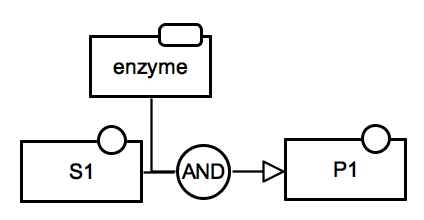 SBGN-ML Newt |
Irreversible reaction. The activities of the enzyme and the substrate (S1) transform into the activity of the product (P1), shown by the use of the positive influence arc. Both substrate and product activities are marked by the simple chemical unit of information. The enzyme activity is represented using the macromolecule unit of information. Logic arcs resulting in the logical operator AND represent the necessity of the combined activities of S1 and enzyme. |
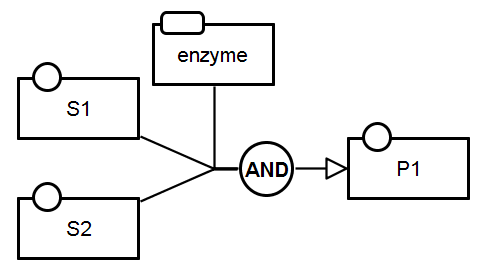 SBGN-ML Newt |
Irreversible reaction: multiple substrates. The activities of the enzyme and two substrate (S1 and S2) transform into the activity of the product (P1). All substrate and product activities are marked by the simple chemical unit of information. The enzyme activity is represented using the macromolecule unit of information. Logic arcs resulting in the logical operator AND represent the necessity of the combined activities of S1, S2 and enzyme. |
Signalling network
 SBGN-ML Newt |
Protein phosphorylation. The kinase activity positively influences the activity of a phosphorylated protein X. Both activities are marked by the macromolecule unit of information. If the phosphorylation leaded to protein deactivation, then the activation arc would have been replaced by an inhibition arc. |
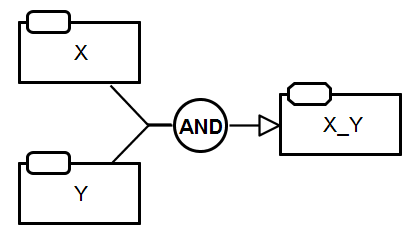 SBGN-ML Newt |
Complex association. The activity X together with the activity Y stimulates the activity X_Y. The identity of X_Y as a complex is represented using the complex unit of information. |
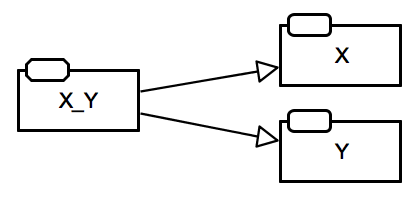 SBGN-ML Newt |
Complex dissociation. The activity X_Y stimulates the activities X and Y. |
 SBGN-ML Newt |
Oligomerisation. The activity of X-2P stimulates the activity of XX-2P. Both activities are phosphorylated at two residues (indicated by suffix -2P in the label). Cardinality cannot be represented in AF, thus the process of homodimerization is indicated by the labels X-2P and XX-2P. |
Gene regulatory network
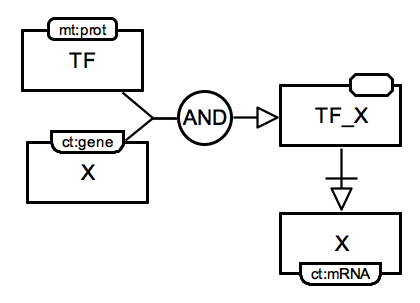 SBGN-ML Newt |
Direct regulation of a target gene by a transcription factor. The activities of a transcription factor (TF) and its target gene (TG) DNA X form a complex TF-X indicating the experimentally verified promoter binding of the TF. The complex identity of TF-X is represented using the complex unit of information. This complex is necessary to stimulate the activity of the TG mRNA X as indicated by the neccessary stimulation connecting arc. The identities of genomic fragment of DNA or RNA as nucleic acid features is represented by the shape of the unit of information and the conceptual types (ct:gene, ct:mRNA) as label in the unit of information. |
 SBGN-ML Newt |
Translation. The activity of X with the nucleic acid feature unit of information with the conceptual type mRNA (ct:mRNA) is necessary to stimulate the activity X with the macromolecule unit of information and the material type protein (mt:prot). |
Functional genomics
AF enables the conceptual representation of biological events with a low level of knowledge or detail. This is suitable for the representation of networks of functional genomics with the focus on interactions between genes and biological processes without mechanistic details.
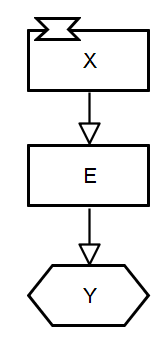 SBGN-ML Newt |
Functional relationship. Any kind of biological event X (such as changing developmental or environmental conditions) is represented using the pertubation glyph and positively influences the species E (in any way). Species E in turn positively influences another biological event Y, represented using the phenotype glyph. |
Transport
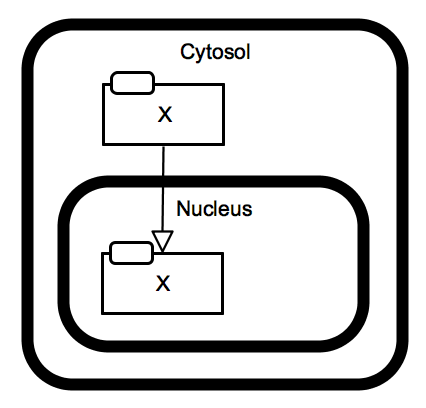 SBGN-ML Newt |
Passive transport. The activity X in the cytosol stimulates the activity X in the nucleus, describing the passive transport of X from one compartment to the other. Cytosolic and nuclear localization are represented using the compartment glyph with the corresponding label. |
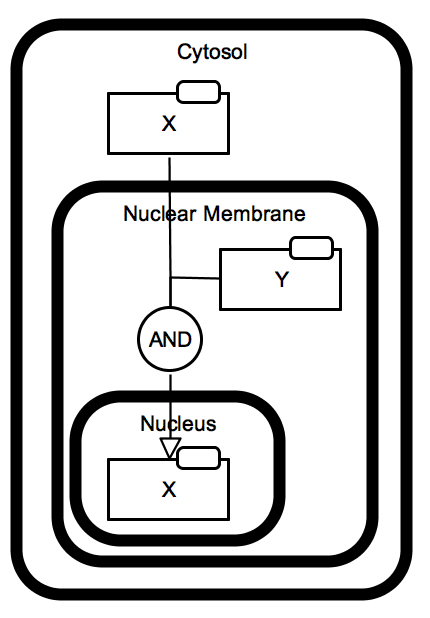 SBGN-ML Newt |
Active transport. The activity X in the cytosol and the activity Y in the nuclear membrane stimulate the activity X in the nucleus, describing the active transport of X from one compartment to the other. Logic arc resulting in the logical operator AND represent the combined activities of X and Y. |